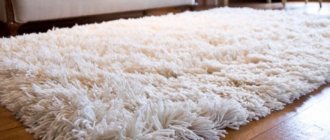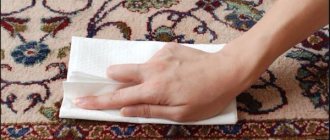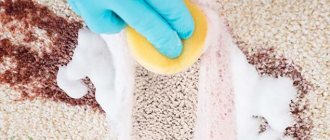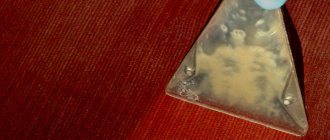Soft, fluffy carpets help create an amazing atmosphere of home comfort and warmth.
But even the highest quality carpet, if not maintained, very quickly loses its attractive appearance.
Secrets of how to vacuum a carpet will help not only keep your home clean and comfortable, but also keep the colors fresh and the floor covering soft.
Choosing the best vacuum cleaner for carpet
There are so many vacuum cleaners available today, from stick vacuum cleaners to robot vacuum cleaners. Not all of them are created equal, so it is important to choose a device that will suit the needs of your carpet.
If you are purchasing a new carpet, check the manufacturer's cleaning recommendations. For example, the new "soft carpets" that are very popular today may require a different type of vacuum than traditional carpeting. The same applies to a vacuum cleaner for long-pile carpets, because
Even if you have a central vacuum cleaner installed, sometimes it won't do the job alone and a new carpet will require an additional purchase.
Trying to choose between an upright or horizontal vacuum cleaner? It's mostly a matter of personal preference; each has its own advantages.
A vertical vacuum cleaner is a single unit consisting of a motor and a suction head. Many upright models even have wheels and other features to make movement easier. If you find it difficult to bend over, it is better to opt for a stick vacuum cleaner. Although they are difficult to use when cleaning stairs.
A typical vacuum cleaner for Russia is a dirt container on wheels and a hose with a nozzle. Its advantage is easier movement between rooms. Great for vacuuming under low furniture such as coffee tables and sofas. Because you pull the vacuum cleaner behind you, it is easier to carry, although it can bump into corners. The downside is that when going from carpet to bare floors, you will most often need to manually change the brush head (unless you need anything more serious than a retractable brush).
Preparing the device for operation
Before you start cleaning, you need to prepare the washing vacuum cleaner. The procedure for using a specific model is usually described in detail in the instructions.
In general, you need to follow a number of simple steps:
- Fill the “clean” reservoir with water or cleaning solution.
- Attach the capillary tube to the spray nozzle and to the connector on the body.
- Connect the capillary to the suction pipe with special clips.
- Connect the suction pipe to the hose.
- Insert the hose into the connector provided for it.
- Pull out the cable and connect the vacuum cleaner to the power supply.
If the model is equipped with filter elements, then a defoamer for the vacuum cleaner should be added to the tank intended for collecting dirty water. Of course, before starting work, all filters must first be cleaned, dried and installed in their designated places.
A washing vacuum cleaner consists of many components that need to be connected correctly. Before each cleaning, check the integrity of the power cable and the tightness of the telescopic tube
Although the vacuum cleaner is called a detergent, it can also be used for dry cleaning. In this case, there is no need to pour water and detergent into the reservoir. This mode will be appropriate for cleaning upholstered furniture, carpets and other surfaces that absorb water.
A particularly high degree of cleaning is provided by washing vacuum cleaners equipped with a steaming function, but it should be remembered that not all coatings tolerate contact with hot steam well.
You should not rely on your own intuitive understanding; before using the washing vacuum cleaner for the first time, you should definitely study the instructions compiled by the manufacturer. If the appliance has not been used for a long time, it is also recommended to refresh your knowledge regarding its correct use.
Using a rotating brush
Many vacuum cleaners come with a rotating brush that is designed to agitate the carpet fibers. This feature is useful for high-pile carpets, but may harm other types of carpets.
Loop style rugs, especially Berber, should not be vacuumed by spinning because it can loosen the fibers and cause the loops to have a fuzzy appearance. And if a small thread gets loose from the loop, it can wrap around the brush and be pulled out with such force that it affects several rows and damages the carpet.
Very long pile carpets can also get stuck in the nozzle. Natural carpets should never be cleaned with such attachments.
Polisher
For those who are faced with the constant problem of rubbing and polishing floors, a completely different electric “assistant” is suitable - a floor polisher. This is a special device that polishes the surface of natural floors after rubbing with mastic and wax. Such devices are indispensable where very large areas are covered with parquet or natural boards, but this device is also suitable for rubbing laminate, tile, and linoleum coverings. When working with the floor polisher, you must guide it, ensure that all surfaces (including wheels) are clean and that the water tanks are dry.
Adjustable height
Adjustable suction head height may be required for different types of carpet. This function is needed if you have several types of carpets at home. It is required to maintain the desired air flow and provide better suction. Set the height according to the vacuum cleaner manufacturer's recommendations for your type of carpet.
Adviсe
During cleaning, it is necessary to ensure that the exhaust air flow from the vacuum cleaner is not directed towards an already cleaned area of the carpet (even the best filter allows the smallest particles of dust to pass through).
Vacuuming must be done in a well-ventilated area, with an open vent or window. This will allow you to quickly clear the air of fine dust scattered around the room during active friction with the vacuum cleaner brush on the fleecy carpet.
A sticky clothes roller will help you clean the carpet in places where you can’t reach with a vacuum cleaner brush . It is enough to roll the roller over the carpet once and there will be no trace left of small debris, wool, or hair.
The Right Action
Before you start vacuuming your carpet, look around and look for small objects in the pile that are too large for the vacuum cleaner (such as toy parts, coins, paper clips, etc.). These items should be picked up by hand to avoid them getting into the vacuum cleaner, which will impair suction or cause damage.
Do not hurry
You need to vacuum the carpet by moving the brush back and forth. There is no need to rush. When there are a lot of other things to do, I myself know that I want to quickly vacuum. However, this does not give the air enough time to pick up all the dust and particles from the carpet fibers, and therefore cleaning will be pointless.
Instead, slowly move the vacuum cleaner in one direction and then pull it towards you. Move on to the next section of the carpet, going lightly over the area you just cleaned to make sure you pick up all the dirt at the joints.
Reverse
For best results, repeat the process in the opposite direction - that is, if you originally vacuumed in a north-south direction, turn around and sweep the brush from east to west. This doesn't have to be done every time you vacuum, but it's best done during deep cleaning.
Be sure to empty the dust bin when it gets full. A full bag or tank will reduce suction power, making the overall job less efficient. It's best to keep the dust bin more than three-quarters full to ensure maximum performance.
How to properly care for a vacuum cleaner. Characteristics and operating rules.
The evolution of the vacuum cleaner began back in 1869, when the Americans decided to find a practical alternative to the broom and broom. The dust collector was supposed to make life easier for housewives.
Today, various models of vacuum cleaners perform all household cleaning with virtually no extra effort: collecting dust and washing floors. All that is required of a conscientious user is proper care of the device.
What is a modern vacuum cleaner? Externally, we see a simple device consisting of a body, a flexible hose, a telescopic tube and nozzles. The principle of operation is as follows: a flow of dirty air mixed with dust and debris enters a system consisting of several special filters, which ultimately leave all the debris in the dust collector and “throw out” clean air outside. The conclusion immediately follows from this: the more often the filters are replaced, the cleaner the air will be released into the atmosphere.
You can find several types of vacuum cleaners in a household appliance store:
— A vacuum cleaner with a dust bag is one of the most well-known household assistants. This type of product operates on the principle of sorting garbage into a bag and filtering clean air. Unfortunately, in this case, housewives forget to clean the bag, which leads to a bad smell and overloaded equipment.
— The cyclone vacuum cleaner is somewhat different from the previous version, more practical and easy to clean. Dust and debris are not “sent” into a bag, but into a proper removable container. One of the advantages is that there is no need to constantly replace the filter. But a smart device also consumes a large amount of energy.
— A vacuum cleaner with a water filter allows you to trap dust particles in a container of water. If you refresh the water every 15 minutes of cleaning, then cleaning the filter will not require at least 4-5 cleanings.
— A handheld vacuum cleaner is convenient for cleaning furniture, hard-to-reach places and cars.
— A robotic vacuum cleaner was released by inventive Chinese who want to find a complete replacement for housewives and deprive their wives of hard housework. Smart technology moves around the room on its own, sucking in debris and dust.
In order for each type of vacuum cleaner to serve its owner for a long time, you need to be able to use the household appliance correctly.
Vacuum cleaner operating instructions:
1. Avoid overheating the vacuum cleaner. You cannot use the device for more than 2 hours without a break.
2. Filters must be changed at least once a month, and dust collectors must be cleaned or washed.
3. Do not use the household appliance at low voltage or when there are sudden changes in voltage.
4. Do not use a vacuum cleaner for the home to clean more contaminated areas, street or industrial.
5. To avoid the risk of electric shock, do not use the vacuum cleaner on wet surfaces.
6. Stop using the equipment if the cord or plug is damaged.
7. It is forbidden to pull a working vacuum cleaner from the network by the cable.
8. Prevent any foreign objects from getting inside that could slow down the operation of the vacuum cleaner. The dust collector is designed only for “storing” small debris.
9. Do not use to suck up flammable or explosive substances.
10. The use of the vacuum cleaner by small children is prohibited.
When choosing an assistant for your home, you need to pay attention to the following important details:
— Power level is one of the most important indicators. The higher the power, the more effective the cleaning will be. Modern vacuum cleaners have power from 1300 W to 2000 W. Accordingly, the smallest power will not clean carpets and surfaces as efficiently, leaving behind small defects. A high-power vacuum cleaner is able to pull debris even from the depths of carpet fibers, while ensuring perfect cleanliness and freshness. — The noise level may depend on several factors: model, power and type. Manufacturers got the hang of it and were able to achieve perfect results with an almost silent cleaning mode. Young housewives often choose a vacuum cleaner with the lowest noise level.
— The type of dust collector was discussed in a detailed description of the types of vacuum cleaner, but it is of no small importance when purchasing. It is impossible to select the most worthy model; in this case, the buyer relies on his own preferences.
All household appliances, without exception, require careful care and proper handling. There are important rules for caring for a vacuum cleaner:
Rule No. 1. Upon completion of the cleaning process, turn off the vacuum cleaner and remove the cord from the power source.
Rule No. 2. The garbage bag must be cleaned of accumulated dust (this procedure must be repeated after each cleaning), washed or washed.
Rule No. 3: Flush the inlet filter if the suction power level drops.
Rule No. 4. Wash used attachments if they become dirty using a brush or sponge.
Rule No. 5. If debris sticks to the vacuum cleaner, do not use alcohol-containing cleaners (acetone, gasoline). Remove carefully using a stiff brush, but not an iron brush, which can damage the surface.
Rule No. 6. Store in the correct position, do not bend or tie the hose too tightly so as not to tear the material.
Rule No. 7. After completing work, wipe the device with a damp cloth inside and out.
Rule No. 8. Monitor the contamination of the output filter and change it if necessary.
When purchasing, the sales consultant is obliged to explain to you the principle of operation of the household appliance, conduct a test check and issue a receipt and warranty card. Any vacuum cleaner has a warranty period: if there is a visible malfunction, the buyer can contact the service center with a breakdown. Any breakdown caused by the user himself can be repaired only at your expense. Therefore, when purchasing a vacuum cleaner, you should follow all the rules for using this product and provide reliable assistants with decent care.
Use attachments
Most vacuum cleaners come with hose attachments, making it easy to clean hard-to-reach areas, as well as vacuum upholstery, curtains, and more. Use a crevice tool along the baseboard around the edge of the room to suck up any accumulated dust.
The upholstery attachment is good for use on delicate surfaces such as wool or silk—fibers that should never be cleaned with a regular attachment. Gently brush the brush with the desired attachment over the delicate material.
If you have a faux carpet with a cut pile, be careful with the edges of the product. A vacuum cleaner with a regular attachment may cause it to unravel.
For stairs, the easiest and most effective way is to use a narrow hose attachment or even the empty end of the hose itself. Run the hose along the edges of the stairs, paying particular attention to areas where dust collects, such as the back where the stringer goes.
Effective dust removers
- Purchased polishes and antistatic agents, such as “Anti-Dust”, prevent the settling of dust particles, effectively clean surfaces and keep them clean for a long time;
- Rose and lavender essential oils, tea tree oil are excellent natural antistatic agents. Just drop a couple of drops of the product onto a wool or microfiber cloth while cleaning;
- You can remove hard polished and decorative surfaces using a glycerin solution. This product is easy to make. To do this, mix glycerin and water in a ratio of 1 to 10;
- Lemon solution is used to clean furniture. It removes dust for a long time and cleans the surface without streaks. To prepare the composition, take one lemon and cut it into pieces, pour in seven tablespoons of any vegetable oil and leave for a week. After seven days of infusion, pour a glass of boiling water into the prepared mixture and strain.
Vacuum more often: but how much?
Most of us don't vacuum every day, but prefer to run the vacuum regularly once or twice a week. No matter how often you do it, you may wonder if it will damage your carpet.
The danger is that the brush stretches and wears out the carpet fibers. In some ways this is true. In fact, dirt does more damage to your carpet than most vacuum cleaners.
If your device has multiple modes, choose a softer, more gentle brush head for extra cleaning.
Some people worry when they see carpet threads in their dust collectors. Does this mean that the vacuum cleaner breaks down the fibers and slowly rips them out? Not really. In general, carpets can be vacuumed several times a week without damaging them. But dirt on the carpet actually breaks down the carpet fibers and also creates a breeding ground for dust mites and bacteria.
The regime is not for the sake of the regime, but for the sake of convenience
How often should you clean and what is better - a little every day or a rare but accurate general cleaning? This question does not have a universal answer and you need to rely on your own convenience or habit.
For some, the daily regime of maintaining cleanliness is normal - doing things little by little so that they don’t accumulate: today - laundry, tomorrow - washing the floors, the day after tomorrow - kitchen chores. This approach has many advantages: it does not waste a lot of time and effort, but without the habit of orderliness it is difficult to implement.
Another option is the accumulation of household chores, which ends with a lot of cleaning. In this situation, which is typical for people accustomed to a free regime, you can not be irritated by everyday hassles, replacing them with something more pleasant, and in a moment of extreme need, do all the accumulated tasks at once.
But if there is a small child in the house, daily cleaning of the children's room becomes an axiom. The only consolation here can be that even wet cleaning of a children's room requires very little time, the bulk of which is spent putting scattered toys and things in their places.
In any case, remember that you have household members who can be organized - at the very least, take part in the cleaning or take on some chores, or, at a minimum, not interfere, which can also be very important.
Recommendations for cleaning the coating
Washing a carpet at home is a complex and time-consuming process, which sometimes does not lead to the best results. First you need to figure out what not to do with the coating. Basic rule:
In addition, a few more recommendations should be followed:
- Do not use various bleaching agents when washing, as they will corrode the color.
- Carpets should be washed in the bathroom or outside. To clean carpet or large surfaces that cannot be moved, it is better to use a washing vacuum cleaner. This will save effort and time.
- Do not wash the carpet in hot water. The maximum temperature should not exceed 50 degrees. Some manufacturers use adhesive bonding during production. Under the influence of high temperatures, the base is destroyed, which inevitably leads to damage to the product. Colored rugs made from natural materials may fade, and coatings containing cotton will shrink. When cleaning wool carpets, use only cold or ice water.
- When washing the coating, do not use brushes with hard bristles, as this will cause damage to the pile. The detergent for cleaning wool rugs should be distributed over the surface with your hands, not with a brush.
- It is not recommended to wash the carpet in a poorly ventilated area. If the coating is not dried enough, fungus and mold grow. High humidity will also destroy the structure of the carpet, which will lead to the formation of holes. Even when washing a small area, it is better to use a hair dryer to dry it.
Rules for caring for a silk carpet
It is better to dry a silk carpet in the fresh air
The cleaning process will be easier and take less time if you know some of the features of silk products and follow the rules.
After treatment with soda and soap, the material will begin to stick slightly, so it is better to use other products at home. Wet cleaning should not be done frequently, as this will damage the fabric.
A natural silk carpet should be dried in conditions with good ventilation, but no more than 12 hours. Otherwise, there is a risk of mold, which is even more difficult to remove.
If the paint on a canvas has faded, no amount of cleaning will bring it back to newness. The carpet will become brighter only due to the absence of dust and dirt.
Professional dry cleaning services for silk carpets are expensive, but the chance of preserving a work of art is higher
It is important to find a company with such experience
Be sure to check the guarantees for quality cleaning. Professionals remove stains not only from the pile, but also from the base, without compromising the integrity of the entire product.











